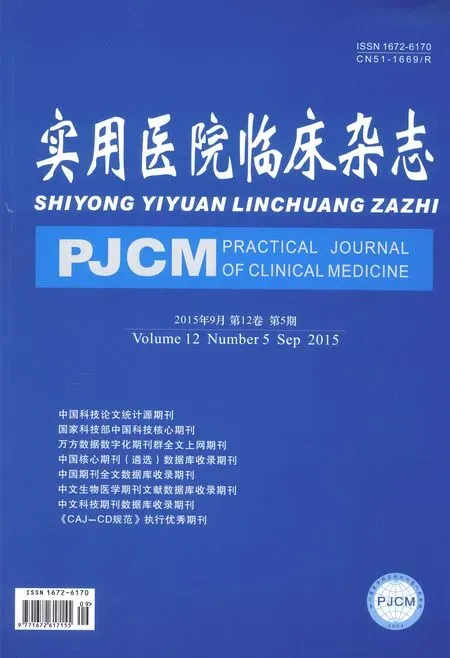全膝关节置换术中自体骨块填塞股骨隧道技术的应用研究
曹万军,朱绍灵,刘显东,唐承杰,郑金文,陈星宇,刘 颖,肖 鹏
(四川省骨科医院下肢科,四川 成都 610041)
全膝关节置换术中自体骨块填塞股骨隧道技术的应用研究
曹万军,朱绍灵,刘显东,唐承杰,郑金文,陈星宇,刘 颖,肖 鹏
(四川省骨科医院下肢科,四川 成都 610041)
目的 比较全膝关节置换术(total knee arthroplasty,TKA)中不处理股骨隧道口、骨水泥填塞及自体骨块填塞三种不同处理方式的效果差异。方法 90例行TKA患者按随机数字表法分为三组,A组采用自体骨块填塞,B组采用骨水泥填塞,C组不处理股骨隧道口,对三组患者术后相关数据进行统计分析。结果 A、B组与C组术中出血量差异无统计学意义(P> 0.05);A、B组术后围手术期总失血量、24 h引流量和输血量均少于C组(P< 0.05),术后各时间点血红蛋白(HGB)及红细胞压积(HCT)水平均高于C组(P< 0.05)。三组输血率分别为10%、13.3%和33.3%,差异有统计学意义(P< 0.05)。A、B组之间各项数据差异均无统计学意义(P> 0.05)。结论 TKA中自体骨块填塞股骨隧道技术可显著减少出血量,其效果与骨水泥填塞技术相当,同时作为自体移植物安全可靠,避免了骨水泥填塞所带来的如骨水泥颗粒脱落、栓塞等风险,效果明显。
自体骨块;全膝置换术;股骨隧道;出血量
全膝关节置换术(total knee arthroplasty,TKA)中如何减少出血量及术后输血率是整个TKA治疗的关键[1]。围绕TKA越来越多的细节也愈加引起大家的重视。而失血量与术中股骨隧道的髓腔出血密切相关[2~4]。对于术中股骨隧道的处理方式多样,主要为骨水泥封堵,或者不予处理。本研究主要目的是探讨TKA术中不处理股骨隧道口、骨水泥填塞及自体骨块填塞三种不同处理方式的效果差异。
1 资料与方法
1.1 一般资料 2014~2015年在四川省骨科医院下肢科行单侧TKA的90例患者。手术均由同一位主刀医生完成。术前5天停用非甾体抗炎药、促红细胞素、镇痛、抗凝等药物排除对研究结果的干扰[5,6],行相同的术前准备方案。纳入标准:①首次行单侧TKA手术且年龄位于50~90岁的骨关节炎和类风湿性关节炎及创伤性骨关节炎患者[7];②术前实验室检查及双下肢静脉彩超均正常;③术前无膝关节开放手术史。排除标准:①凝血功能异常的患者;②既往发生过下肢深静脉血栓(DVT)的患者[8];③严重心、肺、肝、肾功能不全的患者。90例患者按随机数字表法分为三组各30例,三组患者基本资料比较差异均无统计学意义(P> 0.05),具有可比性,见表1。

表1 三组患者一般资料比较
1.2 治疗方法 所有患者均采用全身麻醉+区域阻滞麻醉,均采用止血带技术。均行膝前正中切口,内侧髌旁入路,切开关节囊,彻底清理关节内增生的滑膜组织、骨赘、前后交叉韧带、内外侧半月板;根据关节不同情况行截骨,纠正内外翻畸形;松解挛缩的后关节囊及内外侧结构,保持软组织平衡,恢复关节稳定性;再行测试假体试模与关节匹配稳定后用脉冲冲洗枪冲洗各关节面,擦干后骨水泥固定安装假体。髌骨予以修整成形并行周围神经去极化,未行髌骨置换。待骨水泥干后测试关节活动度,放置引流管,2-0抗菌薇乔可吸收缝线逐层缝合关闭切口,假体均采用施乐辉全膝关节系统。术中操作不同在于截骨完成后对于股骨隧道处理:A组采用自体骨块填塞,B组采用骨水泥填塞,C组不处理股骨隧道口。
A组术中自体骨块均由主刀医生负责处理制作。采用股骨四合一“上斜”截骨时去除的骨块作为自体骨塞制作材料,以咬骨钳修整成长方体形状,大小稍大于股骨隧道口,可确保行填塞时挤压后骨块尺寸与股骨隧道匹配;对于B组,则由放置假体同时骨水泥成团期对股骨隧道行填塞,封堵隧道口即可,并保证填塞表面平整。
三组患者均使用弹力绷带加压包扎,术后24 h拔出引流管,根据患者术后症状及严格按照输血指征针对性输血治疗,术后所有病例均于标准补液、多模式镇痛、标准化功能训练。所有患者均按照《中国预防骨科大手术深静脉血栓形成指南》[9]进行正规抗凝治疗,予低分子肝素钙2周预防深静脉血栓治疗,术后加强踝泵训练、股四头肌肌力训练等,配合被动理疗,术后2周切口拆线出院。
1.3 观测指标 比较三组术中出血量、围手术期总失血量、术后24 h总引流量、输血量、输血率、术后不同时间点血红蛋白(HGB)及红细胞压积(HCT)。其中,围手术期总失血量根据Nadler[10]及Gross[11]等关于失血量计算方法进行计算。对于HGB小于75 g/L的患者予输血治疗,75~100 g/L的患者根据具体情况酌情输血治疗。
1.4 统计学方法 研究数据采用SPSS 19.0软件包进行统计分析。计量资料以均数±标准差表示,组间比较采用方差分析及q检验;计数资料比较采用卡方检验。P< 0.05为差异有统计学意义。
2 结果
2.1 三组术中出血量、围手术期总失血量、术后24 h总引流量、输血量和输血率比较 A、B组及C组术中出血量差异无统计学意义(P> 0.05);A、B组围手术期总失血量、术后24 h引流量和输血量均明显少于C组(P< 0.05),而A、B组之间差异无统计学意义(P> 0.05);三组输血率分别为10%、13.3%、33.3%,差异有统计学意义(P< 0.05),见表2。

表2 三组术中出血量、围手术期总失血量、术后24 h总引流量、输血量和输血率比较
﹡与C组比较,P< 0.05
2.2 不同时间点HGB及HCT值比较 三组术后HGB及HCT均下降,差异有统计学意义(P< 0.05);A、B组术后各时间点HGB及HCT值均高于C组,差异有统计学意义(P< 0.05)。见表3,表4。

表3 三组HGB值比较(g/L)
﹡与术前比较,P< 0.05;△与C组比较,P< 0.05
3 讨论
TKA围手术期血液管理目前已经越来越受到广泛关注和研究,而作为术中及术后的失血控制则显得更为重要。在TKA股骨隧道操作中,松质骨及髓内血管必受到相应损伤而最直接的表现为髓腔渗血导致失血增加[12,13]。从而导致术后输血率的增加,不仅增加治疗费用,同时带来一系列风险,如感染、疾病传播、免疫抑制等[14~17]。而鉴于术后输血的相关并发症风险,随着研究的深入,减少术后失血的方案也越来丰富。

表4 三组HCT值比较
﹡与术前比较,P< 0.05;△与C组比较,P< 0.05
在TKA中,通过骨水泥[18]或者自体骨块[19]关闭股骨定位隧道可以很直接地减少髓腔渗血,从而降低因失血而导致术后输血。结合现有的关于股骨隧道填塞减少失血[20],通过本研究可以看到TKA中自体骨块填塞股骨隧道技术可以显著减少术后失血。Kumar等[21]研究了对于退行性骨关节炎及类风湿性关节炎的全膝置换术中使用自体骨块填塞的疗效,其研究的纳入标准相对较多,研究范围较小,本研究一方面将研究范围扩展到创伤性关节炎,另外一方面研究对象和指标更加全面。
运用自体骨块填塞股骨隧道技术不仅减少术后失血量、降低输血带来的一系列风险[22],同时相对比与骨水泥填塞更具安全性。一方面通过本研究可以发现,自体骨块填塞术后失血与骨水泥填塞结果无明显差异,而且自体骨块避免了骨水泥填塞带来的骨水泥颗粒脱落和栓塞风险增高,特别是在股骨髓腔这个特殊位置发生颗粒脱落致栓塞的高风险。
本研究依然具有一定的限制性,由于研究样本偏少,尚需要进一步大样本研究应证研究结果的可靠性。但是通过本研究已经可以看出在全膝关节置换术中股骨隧道处理的必要性,而自体骨块的运用给临床提供了一个很好的选择。
[1] Sara M,Miguel OA,Emerito CRM,et al.Blood transfusion after primary total knee arthroplasty can be significantly minimised through a multimodal blood-loss prevention approach [J].Int Orthop,2014,38(2):347-354.
[2] Conteduca F,Massai F,Iorio R.Blood loss in computer-assisted mobile bearing total knee arthroplasty.A comparison of computer-assisted surgery with a conventional technique[J].Int Orthop,2009,33(6):1609-1613.
[3] Timothy MD,Justin D.Platelet-rich Plasma does not reduce blood loss or pain or improve range of motion after TKA [J].Clin Orthop Relat Res,2012,470(1):138-143.
[4] Piya P,Sukanis C.Can A Modified robert jones bandage after knee arthroplasty reduce blood loss A prospective randomized controlled trial [J].Clin Orthop Relat Res,2013,471(5):1677-1681.
[5] Jasvinder AS,David GL.Medical and psychological comorbidity predicts poor pain outcomes after total knee arthroplasty[J].Rheumatology,2013,52(5):916-923.
[6] Patrícia RP,Teresa M.Persistent pain after total knee or hip arthroplasty:differential study of prevalence,nature,and impact [J].J Pain Res,2013,6:691-703.
[7] Liana F,Lisa S,Lawrence W.Variability in Recommendations for Total Knee Arthroplasty among Rheumatologists and Orthopedic Surgeons [J].J Rheumatol,2014,41(1):3899.
[8] Kang-Il Kim,Dong-Geun K,Sumit SK.Thromboprophylaxis for deep vein thrombosis and pulmonary embolism after total joint arthroplasty in a low incidence population[J].Knee Surg Relat Res,2013,25(2):43-53.
[9] 中华医学会骨科分会.预防骨科大手术深静脉血栓形成指南[J].中国矫形外科杂志,2009,17(2):118-119.
[10]Nadler SB,Hidalgo JH,Bloch T.Prediction of blood volume in normal human adults[J].Surgery,1962,51(2):224-232.
[11]Gross JB.Estimating allowable blood loss:corrected for dilution [J].Anesthesiology,1983,58(3):277-280.
[12]Deniz C,Bulent O,Cemal A,et al.No difference in blood loss between posterior-cruciate-ligament-retaining and posterior-cruciate-ligament-stabilized total knee arthroplasties[J].Knee Surg Sports Traumatol Arthrosc,2014,22(8):1865-1869.
[13]Hirotaka M,Kotaro I.intra-articular injection of tranexamic acid via a drain plus drain-clamping to reduce blood loss in cementless total knee arthroplasty[J].J Orthop Surg Res,2012,7:32.
[14]Paolo P,Marco V,Laura de G.Blood management and transfusion strategies in 600 patients undergoing total joint arthroplasty:an analysis of pre-operative autologous blood donation[J].Blood Transfus,2013,11(3):370-376.
[15]Manuel M,Robert S,Dafydd T.Laboratory characteristics and clinical utility of post-operative cell salvage:washed or unwashed blood transfusion[J].Blood Transfus,2011,9(3):248-261.
[16]Leif C,Christian P,Kiriakos D.Two-stage revision total knee arthroplasty in cases of periprosthetic joint infection:An Analysis of 50 Cases[J].Open Orthop J,2015,9:49-56.
[17]In Jun K,Woo-Shin C,Nam Yong C.Causes,Risk Factors,and trends in failures after tka in korea over the past 5 years:a multicenter study[J].Clin Orthop Relat Res,2014,472(1):316-326.
[18]Jacklyn RG,Mark AM.In vivo loss of cement-bone interlock reduces fixation strength in total knee arthroplasties[J].J Orthop Res,2014,32(8):1052-1060.
[19]Roy DB,Karyn EK.Does using autograft bone chips achieve consistent bone ingrowth in primary TKA[J].Clin Orthop Relat Res,2012,470(7):1869-1878.
[20]Simon G,Allison JDY,William DB.Fresh osteochondral allografting for steroid-associated osteonecrosis of the femoral condyles[J].Clin Orthop Relat Res,2010,468(5):1269-1278.
[21]Kumar N,Saleh J,Gardiner E,et al.Plugging the intramedullary canal of the femur in total knee arthroplasty:Reduction in postoperative blood loss[J].J Arthroplasty,2000,15:947-949.
[22]Newman JH,Bowers M,Murphy J.The clinical advantages of autologous transfusion.A randomized,controlled study after knee replacement[J].J Bone Joint Surg Br,1997,79:630-632.
Application research of a technique of autologous bone filling femoral tunnel in total knee replacement
CAO Wan-jun,ZHU Shao-ling,LIU Xian-dong,TANG Cheng-jie,ZHENG Jin-wen CHEN Xing-yu,LIU Ying,XIAO Peng
(Division of Lower Limbs,Sichuan Orthopedic Hospital,Chengdu 610041,China)
Objective To compare the effects of three different treatments:no treatment on femoral tunnel or filling with autologous bone or cements plug during total knee arthroplasty(TKA).Methods Ninety patients undergone TAK were randomly divided into A,B and C groups.The group A was treated with autologous bone plugs.The group B was treated with cements.The group C was left the femoral intramedullary defect open.The relative data after operation were statistically analyzed.Results There was no significant difference in intraoperative blood loss among the three groups(P> 0.05).The amount of total blood loss and the amount postoperative wound drainage in 24 h after operation in the group A and B were less than that in the group C(P<0.05).The blood transfusion rates in the group A,B and C were 10%,13.3% and 33.3%,respectively.The levels of HGB and HCT in the group A and B were higher than that in the group C(P< 0.05).The differences were statistically significant(P< 0.05).However,there was no significant difference in all parameters between the group A and B(P> 0.05).Conclusion The autologous bone filling femoral tunnel in TKA can significantly reduce the amount of perioperative blood loss and blood transfusion needs.Its effect is similar to cements but safer as autograft avoiding the risks such as bone cement particles fall off and embolization.
Anautologous;TKA;Femoral tunnel;Blood loss
R684.2
A
1672-6170(2015)05-0105-04
2015-05-26;
2015-06-20)

